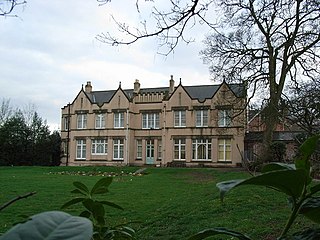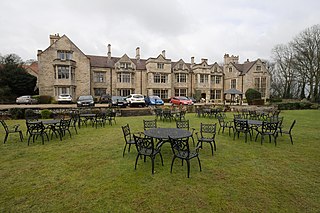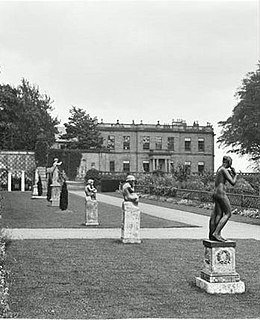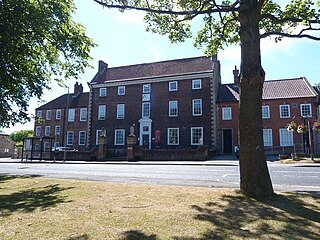
Addington Palace is an 18th-century mansion in Addington near Croydon in south London, within the historic county of Surrey. It was built on the site of a 16th-century manor house. It is particularly known for having been, between 1807 and 1897, the summer residence of the Archbishops of Canterbury. Between 1953 and 1996 it was occupied by the Royal School of Church Music. It is now a conference and wedding venue and country club, while the grounds are occupied by a golf course.

Lambton Castle stands above Chester-le-Street, County Durham and is a stately home, the ancestral seat of the Lambton family, the Earls of Durham. It is listed in the mid-category of listed building, Grade II*.

Low Dinsdale is a village and former civil parish in the borough of Darlington and the ceremonial county of County Durham, England. The Parish population taken at the 2011 census was 871. It is situated a few miles to the south-east of Darlington.

Wilton is a small village in Redcar and Cleveland, North Yorkshire, England. As the population was less than 100 at the 2011 Census details are kept in the ward of Dormanstown.

Herrington is an area in the south of Sunderland, lying within historic County Durham in North East England.

The Moor Hall is a 1905 house, built for Colonel Edward Ansell of Ansells Brewery, in Sutton Coldfield, Birmingham, England. It has been used as a hotel since 1930 and subsequently extended. It is on the site of a former 15th century building. It is also a suburb of the town, situated between the district of Roughley and Sutton town centre.

Axwell House is a mansion house and Grade II* listed building, situated at Axwell Park, Blaydon, Tyne and Wear, England.

Pype Hayes Hall is a former mansion house in the Pype Hayes area of Erdington, Birmingham, England. The hall's grounds now form Pype Hayes Park. It was formerly in the historic county of Warwickshire before being transferred into the new county of the West Midlands, along with the rest of the city, in 1974. It has grade II listed status.

Umberslade Hall is a 17th-century mansion converted into residential apartments situated in Nuthurst near Tanworth in Arden, Warwickshire. It is a Grade II* listed building.

Wroxall Abbey is a substantial Victorian mansion house situated at Wroxall, Warwickshire which was converted for use as a hotel, spa, wedding venue and conference centre. It is a Grade II listed building.

Willersley Castle is a late 18th-century country mansion above the River Derwent at Cromford, Derbyshire, outside Peak District National Park. The castle has been a Grade II* listed building since April 2000.
Low Dinsdale Manor is a privately owned, much altered, and extended medieval moated fortified manor house situated on the north bank of the River Tees at Low Dinsdale, near Darlington, County Durham, England. It is a Grade II* listed building.

Redworth Hall is a 17th-century country house at Redworth, Heighington, County Durham, England now converted to a hotel. It is a listed building.

Windlestone Hall is an early 19th-century country house situated near Rushyford, County Durham, England. It is a Grade II* Listed building.
Aubone Alfred Surtees was an English rugby union forward who played international rugby for the British Isles XV that toured South Africa in 1891.

Biddick Hall is a small privately owned 18th-century country mansion at Bournmoor, County Durham, near the City of Sunderland and Chester-le-Street. It is a Grade I listed building and the home of the Lambton family.
Country house conversion to apartments is the process whereby a large country house, which was originally built to accommodate one wealthy family, is subdivided into separate apartments to allow multiple residential occupancy by a number of unrelated families. They are usually, by virtue of their age or style, listed buildings. The re-purposing of these mansions is one alternative to their demolition; there was wide-spread destruction of country houses in 20th-century Britain, but remodelling them as multiple dwelling units became a more popular option after the Destruction of the Country House exhibition in 1974.

Hardwick Hall in Sedgefield, County Durham is a building of historical significance and is listed on the English Heritage Register. A major part of it was built in the late 1700s but it is possible that some of it dates from about 1634. It was the residence for many notable people for two centuries. It is now a hotel which provides accommodation and restaurant services and caters for special events particularly weddings.

Mount Oswald is a manor house in Durham, County Durham, England. The property, which is being developed for academic and residential use, is a Grade II listed building.

The Manor House in Sedgefield, County Durham was built in 1707 on high ground in a country setting looking on to St. Edmund's Church as a mansion house for wealthy judge Robert Wright. Its notoriety arises from the eminence of the judge of Middle Temple who went on to be Chief Justice of colonial South Carolina and also because it is a rare example of Queen Anne style architecture in an area as far north as Sedgefield, with fine and distinctive architectural features including, reportedly, a wood carving by Grinling Gibbons. In 1756 the house was acquired by John Burdon of nearby Hardwick Estate who installed a noteworthy Palladian Venetian window very likely by the architect James Paine. In the twentieth century the Manor House was the head offices of Sedgefield Rural District Council and after that Sedgefield Magistrates' Court.

















